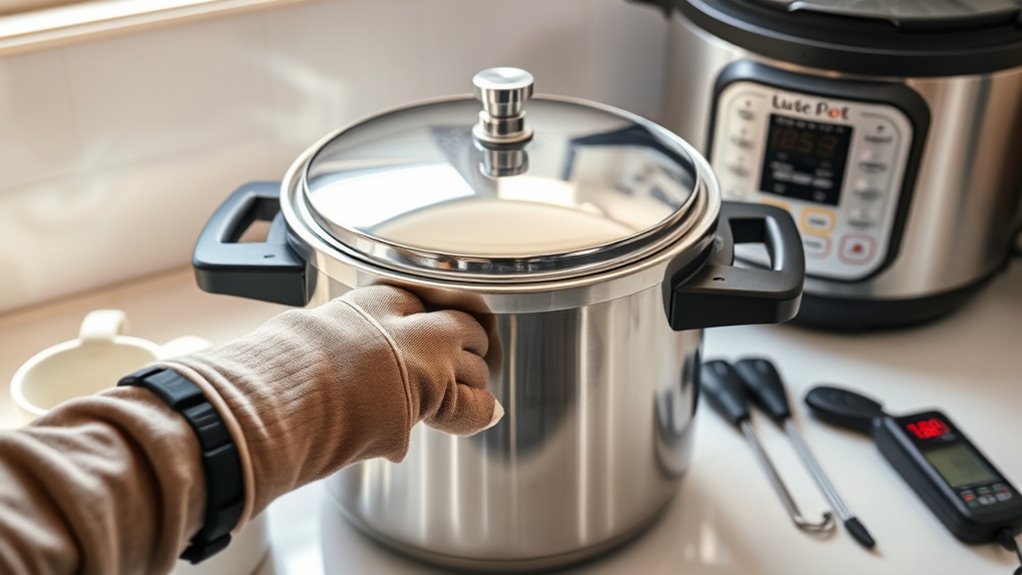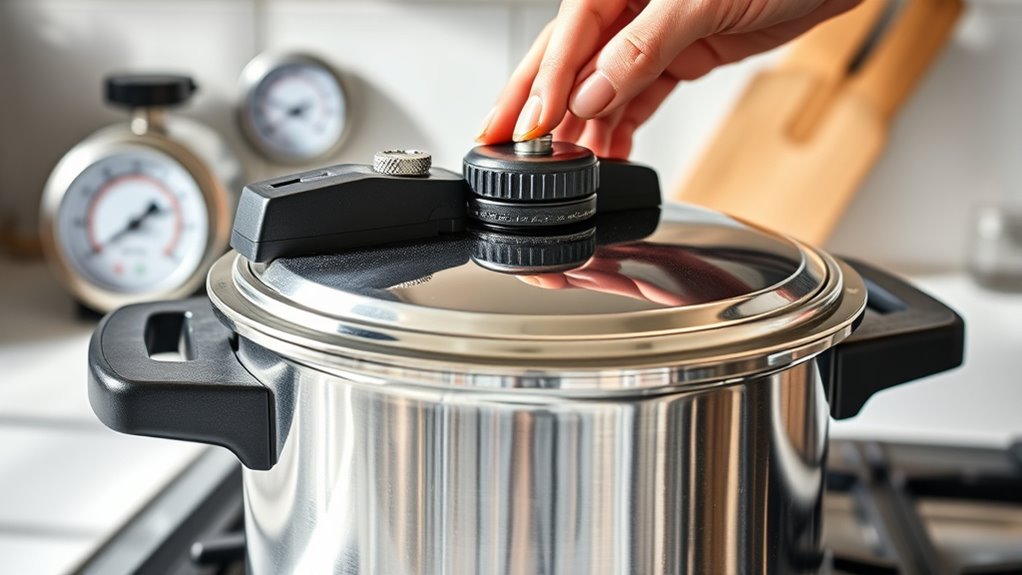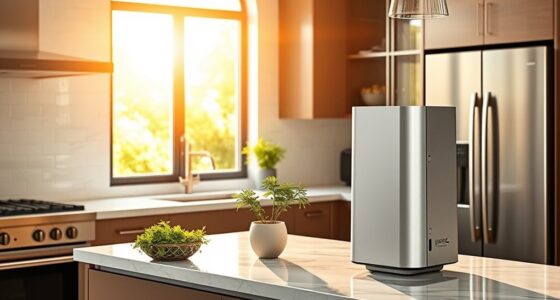To use pressure cookers and multi‑cookers safely, always check that pressure release valves and vents aren’t blocked and inspect gaskets for damage before each use. Follow manufacturer instructions carefully, ensuring the lid locks properly and pressure is fully released before opening. Use the appropriate pressure level for your recipe and never force the lid open. Proper maintenance and vigilance help prevent accidents—keep exploring for more safety tips to enjoy your cooking with confidence.
Key Takeaways
- Regularly inspect and clean the pressure release valve and gasket to prevent blockages and ensure proper sealing.
- Always follow manufacturer instructions for locking the lid and setting pressure levels correctly.
- Confirm that all pressure has fully released before opening the cooker to avoid burns or explosions.
- Avoid tampering with or forcing the pressure release valve; ensure it operates smoothly and is unobstructed.
- Use appropriate pressure release methods (natural, quick, or combined) based on your recipe and safety guidelines.

Using pressure cookers and multi-cookers can save time and make meal preparation easier, but safety should always come first. One of the most important safety features is the pressure release mechanism. This system is designed to safely vent excess steam and prevent dangerous pressure buildup inside the cooker. Always verify that the pressure release mechanism is functioning properly before each use. If your model has a valve or a vent, check that it isn’t blocked or clogged with food debris or residue. Regularly inspecting and cleaning these parts helps avoid accidental pressure buildup, which could lead to dangerous situations. Never force or tamper with the pressure release valve; it’s essential that it operates smoothly and releases pressure at the appropriate time.
Another critical safety aspect is gasket maintenance. The gasket, a rubber or silicone ring inside the lid, creates a secure seal that traps steam and builds pressure. Over time, gaskets can become brittle, cracked, or deformed, compromising the seal and risking steam leaks. Always inspect the gasket before each use, looking for signs of wear and tear. If you notice any cracks, tears, or warping, replace the gasket immediately. Proper gasket maintenance isn’t just about safety; it also ensures your food cooks evenly and efficiently. Keep the gasket clean and dry after washing, and avoid using abrasive cleaners that might damage it. Some gaskets are removable for thorough cleaning—use warm, soapy water and a soft brush to keep it in top condition. Also, store the gasket separately from the cooker if you won’t be using it for a while, to prevent deformities.
In addition, understanding the importance of proper inspection and maintenance can significantly reduce the risk of accidents. When using your pressure cooker or multi-cooker, always follow the manufacturer’s instructions regarding pressure release and gasket care. Each model has specific guidelines for safe operation, including how to properly lock the lid, what pressure levels to use, and how to release pressure safely at the end of cooking. Be cautious when opening the lid—never do so until you’re certain that pressure has fully released. Use the designated pressure release methods, whether that’s a natural release, quick release, or a combination of both, depending on what your recipe requires. These steps keep you safe from sudden steam bursts or scalding. Remember, prioritizing regular maintenance and vigilance with pressure release mechanisms and gaskets will help you enjoy the convenience of your pressure or multi-cooker without risking safety.
Frequently Asked Questions
Can I Leave a Pressure Cooker Unattended During Cooking?
You shouldn’t leave a pressure cooker unattended during cooking. Supervision is necessary because unattended risks include potential over-pressurization, steam leaks, or malfunctions that can lead to accidents or injuries. Always stay nearby and monitor the cooker until it’s safe to open. By actively supervising, you minimize the chances of safety issues and ensure your cooking process remains safe and controlled.
What Should I Do if the Pressure Release Valve Malfunctions?
Imagine your pressure release valve as the gatekeeper of safety; if it malfunctions, act immediately. Turn off the cooker and disconnect it from the power source. Do not attempt to repair the pressure release valve yourself—it’s best to seek professional pressure release valve malfunction repair. Vent the cooker carefully if needed, and always consult your user manual or contact the manufacturer for guidance. Safety first keeps your cooking worry-free.
Are There Specific Foods I Should Avoid Cooking in a Pressure Cooker?
You should prevent cooking foods with food restrictions like certain beans, tough meats, or foods that foam or expand, such as popcorn, in a pressure cooker. These can clog the vent or cause safety issues. Always follow safety precautions, including checking for proper sealing and avoiding overfilling. Staying aware of food restrictions ensures safe operation and prevents accidents, making your pressure cooking experience safer and more enjoyable.
How Often Should I Replace the Pressure Cooker Gasket?
You should replace the pressure cooker gasket every 12 to 18 months, depending on usage and condition. Regular gasket maintenance, including checking for cracks, tears, or warping, helps guarantee safety and proper sealing. If you notice any deterioration or loss of elasticity, it’s time for a replacement. Following a consistent replacement schedule prevents leaks and maintains ideal pressure, keeping your cooking safe and efficient.
Can Pressure Cookers Be Used on Induction Stovetops?
Yes, pressure cookers can be used on induction stovetops if they’re induction compatible. Check the cookware material—magnetic metals like stainless steel or cast iron work best. Make sure your pressure cooker has a flat, magnetic bottom for proper contact. Using incompatible cookware may result in poor heat transfer or damage. Always verify induction compatibility before cooking to guarantee safety and efficient operation.
Conclusion
By following these safety tips, you’ll handle your pressure cooker or multi-cooker like a pro, preventing accidents before they happen. Think of it as steering a ship through calm waters—you want smooth sailing, not rough seas. Always stay attentive, use the right settings, and never rush the process. With these precautions, you’ll enjoy delicious meals safely and confidently, turning your kitchen into a secure haven where cooking feels as easy as a gentle breeze.










